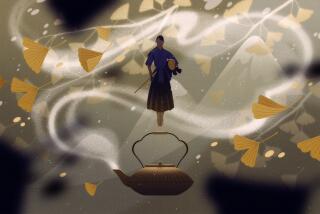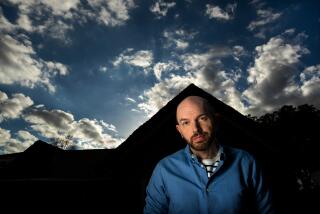Across the land, plots are thickening
- Share via
Once upon a time in a place called San Francisco, a group of lawyers and consultants gathered around a table. An important trial was forthcoming, and they knew it would be a hard-fought battle. Darkness was on the horizon. Millions of dollars in darkness.
How could they convince a jury that the tragedy that had befallen the plaintiffs was not their clients’ fault? The question haunted them, so they sat and pondered, pondered and sat.
Finally, an idea emerged. “A train wreck,” said one man. The real culprit in the case was the ill-fated path the plaintiffs had chosen, and once they were on it, there was no turning back, no stopping the train until it had run its course.
The trial lasted nearly eight weeks, and the jury took a week to decide. But in the end, the lawyers won. And according to G. Christopher Ritter, a consultant who helps lawyers create graphics and strategies, the train wreck analogy was a big reason why.
What’s surprising is that the person who came up with it was not a lawyer or expert in law or even trains. He was a professional storyteller named Joel ben Izzy.
Around such tables, where lawyers, doctors and corporate managers gather, there is a growing demand for storytellers and their advice on how to more effectively connect with juries, patients, clients, employees and even each other.
It’s further evidence of the power of the craft, and the growing presence of this ancient art form. Throughout Southern California there are festivals and groups where people gather to share stories and to study the art form. As a “creative hub,” says Karen Dietz, executive director of the National Storytelling Network, Southern California is one of the most promising and diverse in the country.
Michael D. McCarty is a storyteller from Inglewood who started the Griot Workshop there eight years ago. It used to be that on a good night, one other person might show up. Now up to 25 attend, and many of them, like McCarty, are professional storytellers who sing and dance as they take turns on stage or merely listen. Price of admission? Three bucks if you have it. Including refreshments.
McCarty has performed at the House of Blues and the National Storytelling Festival. He has performed in numerous countries, including South Africa, where he was awarded a candlelight award for sharing hope. An animated performer, he uses storytelling to promote literacy, multicultural understanding, history, sobriety and, always, joy.
Ina Buckner, a teacher, actor and television producer, uses storytelling in her classroom as well as in the mental health unit at Cedars-Sinai, where she volunteers. Known as the “sunshine storyteller,” Buckner most often speaks to children and families.
Ernest Siva, a Native American elder and tribal historian for the Morongo Band of Mission Indians, tells stories at festivals, schools and cultural events. He is working to revive the Serrano language so that songs can be sung and stories can be told in their original form and for their original intent, which was to teach people how to live.
And this weekend at the David Henry Hwang Theater, stories of race and faith in America will be told through “Sacred Moon Songs,” a performance piece incorporating poetry, dance, song and drama presented by Great Leap Inc.
In theaters and coffeehouses, libraries and museums, on porches and around campfires, stories are told not only for entertainment but also to provide insight, and lessons to use in life. Storytellers will tell you that it is an inherent need. Just as we require food and water, we need stories for nourishment and to help us find our bearings.
A story serves as a bridge, and therein lies its power. It begins in one heart and ends in another.
Sharing wisdom
Joel ben Izzy is known as the “traveling storyteller.” He has told tales throughout the country as well as in Europe and Asia. He also has released six recordings and written a book, “The Beggar King and the Secret of Happiness” (Algonquin Books of Chapel Hill), that combines storytelling with personal accounts of how he lost his mentor, his mother and, for a year and a half, his voice to cancer.
He was working a circuit of bar mitzvahs and theater festivals, universities and youth organizations until one day in 1991, when he was invited to speak to lawyers at a Los Angeles firm to talk about how storytelling principles can be used to present complex information to a jury.
Then he started meeting people in the corporate world, helping them use story techniques in speeches and other forms of communication, such as defining services to potential clients.
“In a nutshell, what stories so often can do is take us beyond information, beyond knowledge even to the realm of wisdom,” Ben Izzy says.
And who doesn’t need wisdom?
Ben Izzy earns up to $5,000 a day consulting, which now makes up about one-third of his work.
Canadian storyteller Linda Clarke was walking down an Edmonton street one day when she saw a professor she knew. He asked her what she was doing with her life, and when it turned out she wasn’t doing much, he suggested she work for him at a bioethics center he was starting.
She continued writing and telling stories, mostly folk tales and fairy tales, as she ventured into clinical ethics. When she realized that storytelling and healthcare were really about relationships, she combined them and now serves as narrative medicine artist-in-residence at Dalhousie Medical School in Halifax, Nova Scotia. She teaches medical students how to craft stories, perform them and respect them.
“When you have someone who is in the dying process,” she says, “and you create a time and place where you say, ‘You’re so valuable to me that I want to hear your story,’ that, to me, is profound.”
By learning to write and tell stories, doctors and others in healthcare gain insight about their own feelings as well as the feelings of those around them, Clarke says.
Rita Charon, director of the narrative medicine program at Columbia University, says discussions of literature, like storytelling, have an important role in healthcare.
“We’re sitting around the table today,” she says. “It’s the informatics scientists, the biochemist, the psychologist, the graduate student in English, a couple of internists, a pediatrician or two. We read ‘The Dead’ and in the course of an hour we get to talk about some of the reasons that snow is general all over Ireland. Is it about medicine? No. Is it about being human? Yes, therefore it’s about medicine.”
Cultural memory
It was through song and story, the two of them never far apart, that life’s lessons were taught in native cultures, says Ernest Siva, a storyteller of Cahuilla and Serrano heritage.
Siva, who earned bachelor’s and master’s degrees from USC in choral music and music education, says his education began in his childhood home on the Morongo reservation, where he listened to his grandfather’s tales, never certain which were true and which were made up.
He knows that many of the stories and songs have been lost, archived in memories of the dead, but many remain, he says, and they need to be told to help preserve the cultures. So much of life, he says, has to do with what can’t be seen. Through the light and lens of stories and songs we begin to understand what our eyes cannot explain.
He has helped found the Dorothy Ramon Learning Center and Ushkana Press to help preserve native cultures once held together by stories and songs. Siva also is establishing a cultural heritage center and is studying the Serrano language, which he will teach at UCLA in the fall.
“The educated person was the one who had heard all these things and was able to tell them to someone else,” he says. “The important thing was to tell someone else.”
Planting seeds
Stories hold great power, McCarty says. And the right story at the right time can change a person’s life, which leads to Rule No. 1: Tell a story you believe in.
McCarty is a former organizer of the Los Angeles Storytelling Festival, which takes place Nov. 6 at USC and is an opportunity to see many of the top local tellers.
Each teller must find his own voice, says McCarty, and the festival is an opportunity to see the range in styles as well as the cultural and ethnic diversity that characterizes the region.
Some, like McCarty, can be very animated, laughing wildly, arms waving, eyes glistening like silver dollars.
Others are very still but equally engaging. It’s a matter of allowing the story to tell itself, he says, to pour through the teller like laughter or tears. His own love for story was passed down from his mother, a voracious reader. “As long as you can read, you can do anything,” she would tell him. “You can be president if you want.”
So that has become his message. Plastered all over his Nissan Sentra are bumper stickers with messages such as “The arts are not a luxury,” and “Dare to think for yourself.”
When children see his car, they automatically start reading the stickers. Without knowing it, they are receiving a lesson in literacy. At many of his performances, he gives children free books to take with them.
Stories also can help heal, he says, which is why he tells them at drug rehabilitation facilities. “In storytelling, what you try to do is plant a seed,” he says. “I don’t lecture. I don’t condescend. I don’t tell anybody what they should or shouldn’t do. I just tell them about what happened to me.”
Without story, his experiences with drugs, like any experience, are merely artifacts. The story structure, however, gives them life and transforms them into hope and possibility, which is why he also tells stories of slaves and people of all cultures whose experiences can inspire.
That they have such power leads to Rule No. 2: Respect your stories.
For storytellers, stages are everywhere. Buckner often performs at schools, libraries, festivals and storytelling workshops, but you might also see her standing in the parking lot telling the security guard her tale of the backpack-wearing penguin.
Or she might be in front of the chalkboard at the Metropolitan Skills Center, an adult school where she teaches English. Telling a story, she says, creates a comfort zone where students, some of whom have been in the United States only a couple of weeks, feel at ease in a strange, new environment.
In one class, her students are from El Salvador, Thailand, Korea, Russia, Africa, China, Mexico, Cuba and Egypt. They describe how they heard stories about America while living in their homelands, and how the stories led them here by plane or train, bus or car, by foot or even donkey.
When students share their stories, they begin to understand each other, Buckner says, regardless of what languages they speak.
“We all enjoy the same things,” she says. “I think that’s a magical key that storytelling has, so it can help people get to a common ground so they can communicate and solve problems.”
From each other
“Sometimes ordinary stories, when you put them all together, become extraordinary,” says Nobuko Miyamoto, founder and artistic director of Great Leap Inc.
“Sacred Moon Songs” weaves together stories about race and faith. Through a series of community workshops over the last year, the group solicited stories dealing with dislocation: the internment of Japanese Americans, the repatriation of Mexicans, the Middle Passage of the slavery trade, the deportation of American Muslims to Guantanamo Bay.
Translated into poetry, dance, music and theater, the stories are at the heart of “Sacred Moon Songs.”
The performances this weekend involve a diverse cast of poets and teachers, a Japanese American activist and her Sufi Muslim son, a chiropractor and a Buddhist monk, a dancer and the national outreach coordinator for the Muslim Public Affairs Council as well as a playwright and former leader of a 1970s band called Ruben and the Jets.
Woven throughout the performance are scenes with the Rev. Masanori “Shobo” Ishihara, a Buddhist monk who grew up in an 800-year-old temple in Japan, and Kamau Ayubbi, a Sufi Muslim who grew up in Los Angeles.
“I didn’t know about Latino culture and Muslim culture,” says Ishihara, 32. “Kamau and I have found many similarities between the Muslim and Buddhist point of view. Deep inside, it’s the same thing.”
Ishihara, whose favorite films include “The Godfather” and whose musical tastes range from traditional Japanese music to alternative, country and a bit of hip-hop, was ordained at age 10. Eight years ago, he was assigned to the Jodoshu North America Buddhist Missions in downtown Los Angeles.
“Being with people is the most important thing,” he says. “We cannot learn Buddhism from books. We need situations to experience the teachings.”
Through the sharing of stories, participants say their lives have changed. Learning about Islam has made Ishihara a better Buddhist, and learning about Buddhism has made Ayubbi a better Muslim.
“It’s one of the few things in my life right now that is not pure rhetoric and argument,” says Nader Elmakawi, national outreach coordinator for the Muslim Public Affairs Council. “It’s constructive. It’s building something. People are actually getting to know each other, building relationships across boundaries.”
Tomomi Kanemaru’s story begins on the banks of the East River, where she watched black smoke rise from the World Trade Center.
On Sept. 11, 2001, she was preparing for a show at the Yamanashi Prefectural Museum of Art in Japan. In the days following the attack, she was torn between attending the opening of the show or staying in New York. She chose to go to Japan.
“I could have stayed and helped,” she says, “but I didn’t. I put art ahead of helping others.”
She has not painted since, and, even now, feels tremendous guilt. In October, she moved to Los Angeles, sensing there were no answers for her in New York. That’s when she was introduced to Great Leap.
“Sacred Moon Songs” has reminded her that art can change one thing into another, she says. In the telling of her story, guilt becomes hope.
*
Setting the scene
Here is a sampling of storytelling events and groups in Southern California:
“Sacred Moon Songs,” a performance piece that translates personal stories of dislocation into poetry, dance, music and theater. 7:30 p.m. Friday; 7:30 p.m. Saturday, 2 p.m. Sunday. David Henry Hwang Theater (East West Players), 120 N. Judge John Aiso St., Los Angeles; $20 general admission; $15 children, students and seniors. (213) 250-8800, Ext. 4; www.greatleap.org.
Los Angeles Storytelling Festival, performances by five tellers and four workshops on the art and business of storytelling. Nov. 6 at the USC Davidson Conference Center. (626) 398-1151.
Once Upon a Story Storytelling Festival, performances by tellers from around the country. Oct. 8 and 9 at Historic Town Center Park in San Juan Capistrano. (949) 768-1916.
Community Storytellers meets 7:15 p.m. the second Thursday of each month at Temple Beth Torah, 11827 Venice Blvd., Los Angeles. (310) 823-7482.
Griot Workshop meets 7 p.m. the third Wednesday of each month at 3335 43rd Place near Leimert Park. (310) 677-8099.
San Gabriel Valley Storytellers meets 7:30 p.m. the third Tuesday of each month at Hill Avenue Library, 55 S. Hill Ave., Pasadena. (626) 796-2153.
Prophets and Liars meets once a month at 7 p.m. on Monday or Tuesday at A.K. Smiley Public Library, 125 W. Vine St., Redlands. (909) 798-7945.
South Coast Storytellers Guild meets 7 p.m. the third Thursday of each month at the Guild House in Piecemakers Village, 2845 Mesa Verde Drive East, Costa Mesa. (949) 496-1960. The guild also sponsors storytelling at the Santa Ana Zoo at 11 a.m. every second Saturday.
Sunland-Tujunga Story Swap meets 8 p.m. the second Saturday of each month at Sunland-Tujunga Branch Library, 7771 Foothill Blvd.,Tujunga. (818) 541-9449.
Long Beach Storytellers meets 7 p.m. the first Wednesday of each month at Los Altos Methodist Church, 5950 E. Willow St., Long Beach. www.longbeachstorytellers.com.
Story Salon meets 8 p.m. Wednesdays at Coffee Fix, 12508 Moorpark St., Studio City. (818) 762-0181.
Inland Valley Storytellers meets 7:30 p.m. the second Tuesday of the month at Claremont Forum, 111 S. College Ave., Claremont. (909) 645-9147.
More to Read
Sign up for Essential California
The most important California stories and recommendations in your inbox every morning.
You may occasionally receive promotional content from the Los Angeles Times.










